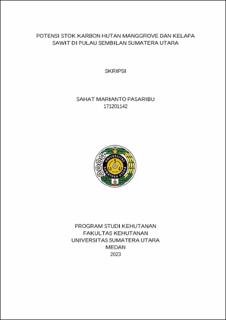Potensi Stok Karbon Hutan Manggrove dan Kelapa Sawit di Pulau Sembilan Sumatera Utara
Potential Carbon Stocks of Mangrove Forest and Oil Palm in Pulau Sembilan, North Sumatra

Date
2023Author
Pasaribu, Sahat Marianto
Advisor(s)
Basyuni, Mohammad
Sasmito, Sigit Deni
Metadata
Show full item recordAbstract
Indonesia is an archipelagic nation who has among world’s greatest natural
resources and the biodiversity, one of which is coastal mangrove forest. One of
mangrove forests functions is natural carbon sinks, with this function allows
mangrove forests to store large amounts of organic carbon, through the form of
vegetation (biomass) and soil organic matter. This research was conducted to
better understand the ecological and social benefits of mangrove functions as
carbon sinks, and develop strategies for mangrove conservation to maximize their
potential benefits, especially mangrove forests in Pulau Sembilan Village,
Pangkalan Susu sub-district, Langkat Regency, North Sumatra. There were 11
mangrove species encountered in natural mangrove forests as well as in restored
mangrove forests across sampling areas. Non-destructive vegetation and oraganic
matter sampling was completed by establishing six circular plots with a radius of 7
m across 125 m transect perpendicular to estuary water body. The assessed carbon
stock consists of three components of the carbon pool, namely tree biomass, root
biomass and dead wood. The average total carbon stock in natural mangrove
forests was 228 MgC/ha, restored mangrove forests was 116 MgC/ha, logged
mangrove was 69 MgC/ha and oil palm plantations was 18 MgC/ha.
Collections
- Undergraduate Theses [1996]
